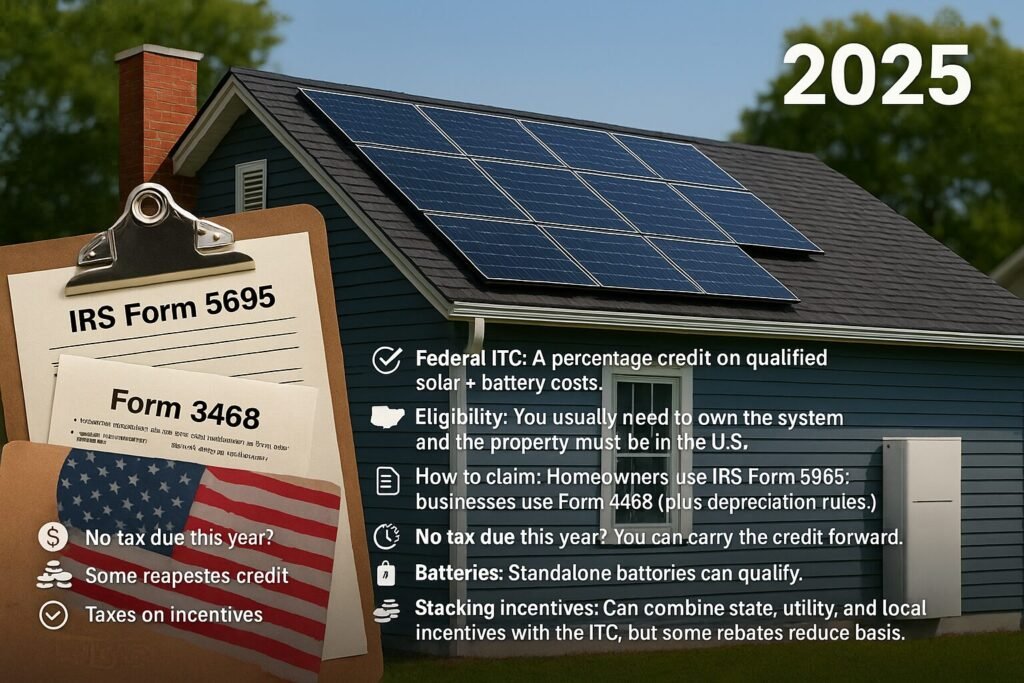Federal & State Solar Tax Credits: Simple 2025 Guide
Clear 2025 guide to federal and state solar incentives: who qualifies, what costs count, how to claim, stack rebates, batteries, timing, and common pitfalls.
TL;DR Snapshot (Skimmers, start here)
- Federal ITC: A percentage credit on qualified solar + battery costs.
- Eligibility: You usually need to own the system, and the property must be in the U.S.
- How to claim: Homeowners use IRS Form 5695; businesses use Form 3468 (plus depreciation rules).
- No tax due this year? You can carry the credit forward.
- Batteries: Standalone batteries can qualify.
- Stacking incentives: You can combine state, utility, and local incentives with the ITC, but some rebates reduce the basis.
- Taxes on incentives: Some rebates/SRECs may be taxable income.
- Timing: Claim in the year the system is placed in service (passes inspection/turns on).
- Leases/PPAs: The owner (usually not the homeowner) gets the credits.
- Businesses: §48 ITC + bonus/accelerated depreciation + possible adders.
Why this matters
When I installed my first PV system, incentives were the difference between “maybe someday” and “let’s do this.” The tricky part wasn’t the gear; it was the paperwork. Which costs qualify? What if my install crossed calendar years? And do batteries really count?
This guide is the one I wish I had—clear, step-by-step, and honest about the gotchas. Whether you’re a homeowner, landlord, small business, or community-solar subscriber, you’ll find plain-English answers here.
1) Quick Definitions (No Jargon)
- ITC (Investment Tax Credit): A federal income tax credit equal to a percentage of eligible project costs.
- §25D vs. §48: §25D is the residential credit (individual taxpayers). §48 is the business/commercial credit.
- “Placed in service”: Your system is installed, inspected, interconnected, and ready to operate.
- Rebate vs. Tax Credit: A rebate is money paid to you (often by a utility/state). A tax credit directly reduces your tax.
- Performance incentives (SRECs/PBI): Ongoing payments based on your energy production.
- Adders: Extra credit percentages for things like domestic content, energy communities, or low-income projects (mostly business/nonprofit contexts).
2) The Federal ITC: Current Rate & What Costs Qualify
2.1 The Current Rate at a Glance
The residential ITC provides a percentage credit of eligible costs for systems placed in service in qualifying years. (We keep a “Last Updated” tag on MicroHomesteader because federal rules can change. Bookmark this post.)
2.2 Eligible Costs (Typical)
- Solar equipment: Panels, microinverters/string inverters, racking, combiner boxes.
- Storage: Batteries and battery inverters (see §2.3).
- Balance of system: DC/AC wiring, conduit, junction boxes, and monitoring hardware.
- Soft costs: Labor, permitting, engineering, inspections, and interconnection fees.
- Related roof work: Mounting hardware and work integral to solar (not a full unrelated reroof).
Skim-Stopper: If it’s necessary for solar and on the same project, it usually qualifies. Cosmetic or unrelated repairs usually don’t.
2.3 Batteries & Special Rules
- Standalone batteries can qualify for the federal credit.
- Paired batteries with PV also qualify.
- Use cases vary (backup vs. daily cycling). Keep documentation showing the battery is part of your renewable energy system.
2.4 What Usually Doesn’t Qualify
- Unrelated roof replacements, structural upgrades not driven by solar, tree removal, and purely cosmetic work.
3) Eligibility: Who Can Claim It?
3.1 Property Types
- Primary home, second home, vacation home can qualify under §25D if you own them and they’re in the U.S.
- Condos/townhomes: You can often claim your allocable share if you own the system (or your share) and pay for it. Check HOA rules.
3.2 Ownership vs. Renting
- Owner-occupied: You buy and own the system → you claim the credit.
- Renters: Typically can’t claim the residential ITC on a landlord’s property, but see community solar below.
- Landlords: May fall under §48 business rules (see Section 10).
3.3 Location & Use
- The system must be in the United States.
- Mixed personal/business use? You may need to allocate costs and choose the correct credit (§25D vs §48).
4) How to Claim the Federal Credit (Step-by-Step)
4.1 Forms & Flow
- Homeowners: File IRS Form 5695 (Residential Energy Credits). The result flows to Schedule 3 and then to Form 1040.
- Businesses: Typically Form 3468 (Investment Credit), plus depreciation (MACRS/bonus) on Form 4562 (see Section 10).
4.2 Documentation Checklist (Save as PDF)
- Signed contract(s) and paid invoices (itemized).
- Proof of placement in service (inspection sign-off/PTO letter).
- Interconnection approval, permit documents, and final as-built or spec sheets.
- Photos of the install (labels/serials help).
- For condos/HOAs: allocation statements or minutes showing your share.
4.3 Pro Tips
- Names/addresses must match your tax return.
- Keep a folder named “Solar_YYYY_Project” with subfolders for Invoices, Permits, PTO, and Photos.
- Save digital and printed copies. Future, you will thank yourself.
5) Don’t Owe Enough Tax This Year? Carryforward Basics
- If your credit exceeds your tax, you can carry the unused portion forward to future years.
- Keep track of how much you used and how much you carried forward.
- Example: Your credit is $7,500, but you only owe $3,000 this year → you may carry forward $4,500.
6) Batteries: Standalone vs. Paired
- Standalone batteries can qualify for the ITC even without new panels.
- Paired batteries qualify when installed with PV or added later.
- Practical tip: Note your battery size (kWh), inverter type, and operating mode (backup vs. time-of-use shifting). Save screenshots of commissioning settings.
7) Stacking State & Utility Incentives with the Federal ITC
7.1 Interaction Rules
- Some rebates (especially cash rebates) may reduce your federal ITC basis.
- State tax credits typically do not reduce basis; they affect your state tax, not the federal project cost.
- Performance incentives (SRECs/PBIs) are usually separate and don’t change the upfront basis, but see taxes in Section 8.
7.2 Timing Considerations
- If you receive a rebate in a later tax year, you may need to adjust how you account for basis and timing. Keep notes and confirmations from the program.
7.3 Examples
- Simple: $20,000 project; $1,000 utility rebate that reduces basis → federal basis = $19,000.
- State credit: $2,000 state tax credit (not a rebate) generally doesn’t reduce your federal basis.
- PBI: Quarterly production payments don’t reduce basis but may be taxable (next section).
8) Are Rebates/SRECs Taxable?
- Utility/state rebates may be taxable income depending on the program structure.
- SRECs (or performance payments) are generally income.
- Practical impact: If you get $1,200 in SREC income and you’re in a 22% bracket, your after-tax benefit is ~$936. Budget with taxes in mind.
9) Can You Stack Multiple Incentives?
Short answer: Usually, yes.
- You can combine the federal ITC with state tax credits, utility rebates, and performance incentives.
- Watch for basis reductions from certain rebates and eligibility windows/ caps.
- Low-income, energy-community, and domestic-content adders mainly apply on the §48 business/nonprofit side.
10) Business & Rental Property Incentives (Commercial §48)
10.1 §48 vs. §25D
- Owner-occupied home: usually §25D.
- Business property/landlord systems: often §48 (commercial ITC).
10.2 Bonus & Accelerated Depreciation
- Under §48, you can pair the ITC with MACRS and potentially bonus depreciation.
- Note: Depreciation basis is generally the project cost minus half of the ITC (basis reduction concept).
10.3 Adders (Domestic Content, Energy Community, Low-Income)
- Qualifying projects may get extra percentage points added to the ITC.
- Each adder has specific documentation and eligibility requirements (supply-chain certifications, geographic criteria, allocation windows for low-income, etc.).
10.4 Use Cases
- Owner-occupied small business: Rooftop PV on your shop → §48 + depreciation.
- Landlord: PV on a rental → likely §48 (and allocate between personal vs. rental use if mixed).
11) Timing Rules: Which Tax Year?
- You claim the credit in the year the system is placed in service (commissioned, inspected, and energized).
- Contracts don’t control the year; operational status does.
- If your install spans December–January, you likely claim in the later year when it passes inspection/PTO.
12) Leases, PPAs, and Community Solar: Who Gets the Credit?
- With a lease or PPA, the third party owns the system and typically takes the credits. You benefit via lower energy costs—not via the ITC.
- Community solar: If you’re a subscriber, you usually don’t take the credit. If you own a share of the project assets directly, different story—get that in writing.

13) Example Walkthroughs (Numbers You Can Copy)
A) Typical Homeowner
- Project: $22,000. Utility rebate: $1,000 → federal basis $21,000.
- Federal ITC = % × $21,000 (based on current rate when placed in service).
- If the state offers a $2,000 state tax credit, it doesn’t reduce the federal basis.
- If you owe less tax this year than the credit, carry forward the remainder.
B) Small Business Rooftop
- Project: $90,000 under §48. ITC applies + MACRS (basis reduced by half the ITC).
- Potential bonus depreciation accelerates deductions.
- If eligible for energy-community or domestic-content adders, the ITC percentage may increase.
C) Battery-Only Upgrade (Homeowner)
- Add a standalone battery to your existing PV. If placed in service in a qualifying year, the battery portion can qualify for the residential ITC.
- Keep itemized invoices showing clear battery hardware + labor costs.
D) Community Solar Subscriber
- Monthly credit on your bill is tied to farm production. No ITC for you as a subscriber (you don’t own the asset), but you can still save on electricity.
14) Docs & Record-Keeping: Your “Audit-Ready” Folder
- Keep for years: Contracts, invoices, permits, inspection sign-offs, PTO, interconnection, photos, program approvals, SREC statements.
- Use a simple naming pattern:
2025_Solar_Project/Invoices/Invoice_01.pdfetc. - Back up to cloud + USB. Email yourself a summary with links to files.
15) Common Pitfalls & How to Avoid Them
- Basic mistakes: Treating a cash rebate like a tax credit. Rebates can reduce basis; state tax credits typically don’t.
- Roof confusion: Counting an unrelated reroof as eligible. Only solar-related roof work counts.
- Timing errors: Claiming by contract date instead of the date placed in service.
- Ownership mismatch: Expecting credits on a lease/PPA.
- Missed deadlines: State programs often have budgets/waitlists—apply early.
16) FAQ (Fast Answers)
- DIY installs? Hardware and qualified costs may count, but keep itemized invoices and proof that it’s safely placed in service.
- Parents paid? The person who owns the system and pays generally claims; talk to a tax pro if multiple parties contributed.
- Off-grid cabins/second homes? Often eligible if in the U.S. and you own them; allocation may apply if mixed use.
- EV chargers/heat pumps? Separate incentives exist; different forms and rules.
- Condo/HOA roofs? You can sometimes claim your pro-rata share if you paid for it and own the share.
17) Pick Your Path (Internal Links)
- New to solar? Read: [Understanding Solar Power: A Beginner’s Guide to Self-Sufficient Living]
- Costs: [How Much Do Solar Panels Cost in 2025]
- ROI: [Are Solar Panels Worth It? ROI & Payback Period]
- Hardware: [Solar Panel System Components Explained]
- Placement: [Optimal Angle & Placement for Solar Panels]
- Maintenance: [Solar Panel Cleaning Guide]
Practical Takeaways
- Make a clean paper trail.
- Understand the basis and how rebates affect it.
- Placing in service controls your tax year.
- Leases/PPAs are great for cash flow, but credits go to the owner.
- If business/rental, model §48 + depreciation, and check adder eligibility.
